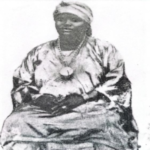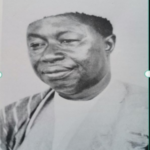NANA AGYEMAN
Nana Agyeman (circa 1790-1867) was ruler of the state of Akyem Kotoku, then located about 60 mi (96 km) northeast of Accra, for more than 40 years (1825-1867). Before his enstoolment, he was known as Kofi Aboagye. During his reign. he developed his capital, Gyadam, into the most populous and beautiful city in Akyem Abuakwa, the state within the boundaries of which Akyem Kotoku was then located. After the war between the peoples of Akyem Kotoku and Akyem Abuakwa in 1860. which resulted in the expulsion of the Akyem Kotoku, he led his people to settle at Nsuaem (modern Oda), 45 mi (72 km) north-north-west of the port of Winneba, and laid the foundations for the political, economic, and social development of modern Akyem Kotoku.
A nephew of a former Kotoku ruler, Kwakye Adeyefe (ruled 18? – 1814), Nana Agyeman was recalled to Gyadam early in 1825 from Akyem Swedru, located 45 mi (72 km) to the southwest, where he had been living in exile. He was installed as ruler in succession to the late Afrifa Akwada (ruler circa 1824-1825). who had originally led the Kotoku migration to Akyem Abuakwa from Asante in 1824.
Nana Agyeman and his subjects fought as allies of Ohemaa (Queen} Dokua of Akyem Abuakwa at the battle of Katamanso (Akantamasu) in 1826, at which a coalition of forces defeated the Asante army. When peace was restored, Nana Agyeman and his people applied themselves diligently to the development of Gyadam. Gyadam flourished, and attracted the attention of both the Wesleyan and the Basel missionaries in the early 1850s. The town was located on the Birem River, about 15 mi (24 km) north of the Akyem Abuakwa capital of Kyebi.
The first missionary, and probably the first European, to visIt Was the Rev. Simon Suss of the Basel Mission, who arrived in January 1852, and was struck by the agricultural productivity of the region, and especially with Nana Agyeman’s house which he described as a “real palace.” He was welcomed by Agyeman, and returned to Akuropon in the neighboring state of Akuapem after a two-day stay, Influenced by the prosperity of Gyadam and the village in its proximity, as well as by Agyeman’s favorable attitude to Europeans, Suss returned to Gyadam in September 1853 to set up the first Basel Mission station on Akyem Abuakwa soil, in temporary accommodation provided by Nana Agyeman. Missionary work enjoyed moderate support and success at Gyadan. By 1860 a permanent missionstation had been built there.
But mounting differences between the Kotoku and the hosts, relating to gold mining profits, according to one account, led to an outbreak of fighting between the Kotoku and the people of Akyem Abuakwa in 1860. Gyadam was destroyed. and the defeated Kotoku led by Agyeman, took refuge at Akyem Swedru, Through the good offices of Queen Amoako of Akyem Swedru, the Kotoku refugees obtained the grant of a piece of land from the Wankyi stool for the foundation of their own settlement, Nsuaem (modern Oda). in 1863.
In the same year peace Was concluded between the peoples of Akyem Abuakwa and Kotoku after an embassy had been sent to Kyebi by the British governor and three Fante rulers. After the conclusion of peace, Nana Agyeman spent his last years working on the establishment of his state at its present location. centered on the town now named Oda, He died in 1867.


